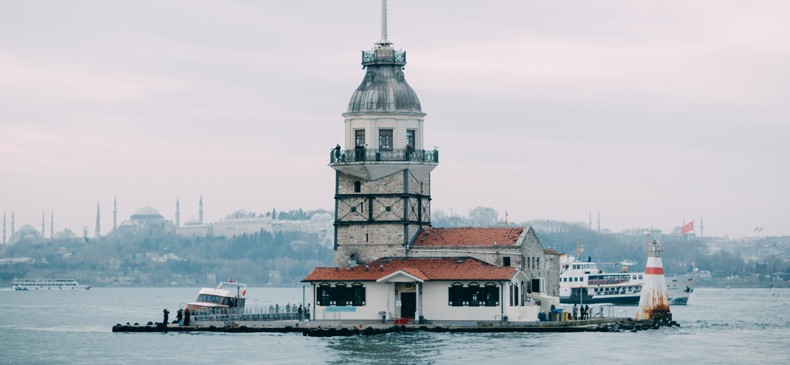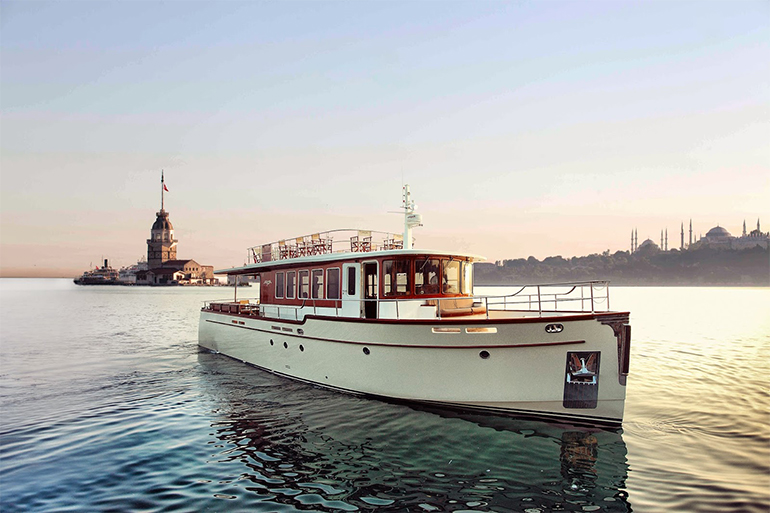Maiden's Tower

The Maiden's Tower (Turkish: Kız Kulesi), also known as Leander's Tower (Tower of Leandros) since the medieval Byzantine period, is a tower lying on a small islet located at the southern entrance of the Bosphorus strait 200 m (220 yd) from the coast of Üsküdar in Istanbul, Turkey.
After the naval victory at Cyzicus, the ancient Athenian general Alcibiades possibly built a custom station for ships coming from the Black Sea on a small rock in front of Chrysopolis (today's Üsküdar). In 1110 Byzantine Emperor Alexius Comnenus built a wooden tower protected by a stone wall. From the tower an iron chain stretched across to another tower erected on the European shore, at the quarter of Mangana in Constantinople. The islet was then connected to the Asiatic shore through a defense wall, whose underwater remains are still visible. During the Ottoman conquest of Constantinople (Istanbul) in 1453, the tower held a Byzantine garrison commanded by the Venetian Gabriele Trevisano. Subsequently, the structure was used as a watchtower by the Ottoman Turks during the reign of Sultan Mehmed the Conqueror.
_by_Florentine_cartographer_Cristoforo_Buondelmonte.jpg) The tower, often mistakenly named Leander's Tower in reference to the legend of Hero and Leander (which took place in the Dardanelles strait, also known as the Hellespont in antiquity), was destroyed during the earthquake of 1509, and burned in 1721. Since then it was used as a lighthouse, and the surrounding walls were repaired in 1731 and 1734, until in 1763 it was erected using stone. From 1829 the tower was used as a quarantine station, and in 1832 was restored by Sultan Mahmud II. Restored again by the harbour authority in 1945, the most recent restoration began in 1998 for the James Bond movie The World Is Not Enough, and steel supports were added around the ancient tower as a precaution after the 17 August 1999 earthquake.
The tower, often mistakenly named Leander's Tower in reference to the legend of Hero and Leander (which took place in the Dardanelles strait, also known as the Hellespont in antiquity), was destroyed during the earthquake of 1509, and burned in 1721. Since then it was used as a lighthouse, and the surrounding walls were repaired in 1731 and 1734, until in 1763 it was erected using stone. From 1829 the tower was used as a quarantine station, and in 1832 was restored by Sultan Mahmud II. Restored again by the harbour authority in 1945, the most recent restoration began in 1998 for the James Bond movie The World Is Not Enough, and steel supports were added around the ancient tower as a precaution after the 17 August 1999 earthquake.
The interior of the tower has been transformed into a popular café and restaurant, with an excellent view of the former Roman, Byzantine and Ottoman capital. Private boats make trips to the tower several times a day.
Legend
There are many legends about the construction of the tower and its location. According to the most popular Turkish legend, an emperor had a much beloved daughter and one day, an oracle prophesied that she would be killed by a venomous snake on her 18th birthday. The emperor, in an effort to thwart his daughter's early demise by placing her away from land so as to keep her away from any snakes, had the tower built in the middle of the Bosphorus to protect his daughter until her 18th birthday. The princess was placed in the tower, where she was frequently visited only by her father.
On the 18th birthday of the princess, the emperor brought her a basket of exotic sumptuous fruits as a birthday gift, delighted that he was able to prevent the prophecy. Upon reaching into the basket, however, an asp that had been hiding among the fruit bit the young princess and she died in her father's arms, just as the oracle had predicted. Hence the name Maiden's Tower.
The older name Leander's Tower comes from another story about a maiden: the ancient Greek myth of Hero and Leander. Hero was a priestess of Aphrodite who lived in a tower at Sestos, at the edge of the Hellespont (Dardanelles). Leander (Leandros), a young man from Abydos on the other side of the strait, fell in love with her and would swim every night across the Hellespont to be with her. Hero would light a lamp every night at the top of her tower to guide his way.

Succumbing to Leander's soft words, and to his argument that Aphrodite, as goddess of love, would scorn the worship of a virgin, Hero allowed him to make love to her. This routine lasted through the warm summer. But one stormy winter night, the waves tossed Leander in the sea and the breezes blew out Hero's light, and Leander lost his way, and was drowned. Hero threw herself from the tower in grief and died as well. The name Maiden's Tower might also have its origins in this ancient story.
Due to the vicinity and similarity between the Dardanelles and the Bosphorus, Leander's story was mistakenly attributed to the tower.
The tower today
Today, there is a restaurant in the first floor and a café at the top of the tower.
The tower was depicted on the reverse of the Turkish 10 lira banknotes of 1966–1981.

